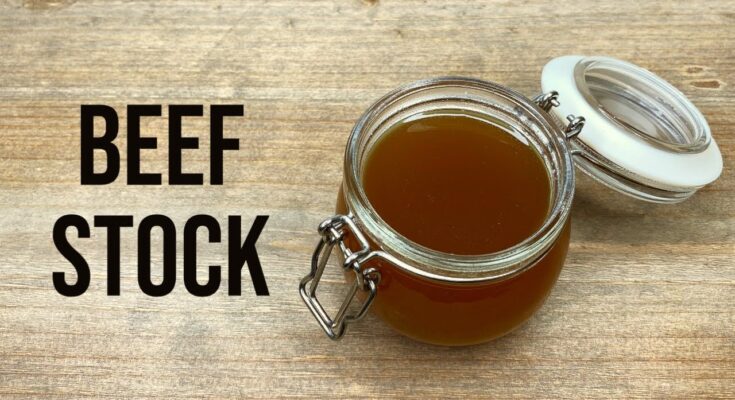Beef Stock Recipe: Beef stock is one of those foundational kitchen staples that can transform your cooking from good to gourmet. It’s not just a liquid base—it’s a rich, nourishing essence packed with flavor, nutrients, and that irresistible umami depth. From hearty soups to luxurious sauces, a well-made beef stock sets the tone for your entire dish. Unlike store-bought versions, homemade beef stock gives you full control over the taste, texture, and nutrition.
Besides adding depth to dishes, beef stock is also celebrated for its health benefits. It’s rich in collagen, amino acids, and minerals extracted from slow-simmered bones and vegetables. That means it’s not only tasty but also good for your joints, gut, and immune system.
Let’s dive into making a classic, deeply flavorful beef stock from scratch.
What You’ll Need
Before we roll up our sleeves, let’s talk about what goes into a good beef stock. While the ingredients list is fairly simple, each item plays a vital role in building the complex flavors we want.
Essential Ingredients:
- 4–5 lbs beef bones (marrow bones, knuckle bones, and oxtail work best)
- 2 medium carrots, roughly chopped
- 2 celery stalks, roughly chopped
- 1 large onion, quartered (no need to peel)
- 3–4 garlic cloves (smashed)
- 2 tablespoons tomato paste
- 2 bay leaves
- 1 tablespoon whole black peppercorns
- 2–3 sprigs fresh thyme (or 1 tsp dried)
- 1 tablespoon apple cider vinegar or white vinegar (helps extract minerals)
- Water (enough to cover the ingredients in the pot)
Tools and Equipment:
- Large roasting pan
- Large stock pot or slow cooker
- Fine mesh strainer or cheesecloth
- Tongs or slotted spoon
- Ladle
- Storage containers (for freezing or refrigeration)
You don’t need fancy gadgets to make stock—just a bit of patience and a few hours to let all the goodness slowly infuse.
Choosing the Right Bones
Not all bones are created equal when it comes to stock. The choice of bones can dramatically impact the flavor and texture of your beef stock.
Best Bones for Rich Flavor:
- Marrow bones: Provide deep flavor and richness.
- Knuckle bones: High in connective tissue, great for a gelatinous texture.
- Oxtail: Offers a meaty, hearty punch and plenty of collagen.
- Shank bones: A mix of meat, marrow, and connective tissue—ideal for stock.
A mix of these bones is your best bet. You want some with meat, some with connective tissue, and some that bring a rich marrow flavor.
Roasting vs. Raw Bones:
This step is optional but highly recommended. Roasting bones at 400°F for about 30–40 minutes brings out deep, caramelized flavors you simply can’t get from raw bones alone. If you’re after a dark, rich stock, roasting is non-negotiable. If you prefer a lighter broth, feel free to skip it.
Step-by-Step Beef Stock Recipe
Ready to make magic? Here’s how to make beef stock step-by-step. It’s easier than it sounds—just a bit time-consuming.
Step 1: Roasting the Bones
Preheat your oven to 400°F (200°C). Place the bones in a single layer on a roasting pan. Roast for 30–45 minutes until they’re browned and fragrant. This step gives the stock that deep, complex flavor base. If you’re using tomato paste, smear it over the bones halfway through roasting to intensify the flavor and add a rich color.
Step 2: Adding Vegetables
Once the bones are roasted, transfer them into a large stock pot. Add the chopped carrots, celery, onion, and garlic. Don’t worry about peeling—those onion skins and veggie ends still have a lot to offer.
Deglaze the roasting pan with a bit of hot water or wine and pour it into the stock pot—this step captures all those flavorful brown bits.
Step 3: Simmering the Stock
Fill the pot with cold water, just enough to cover the bones and veggies. Add bay leaves, peppercorns, thyme, and vinegar. Slowly bring the pot to a gentle simmer over medium heat. Don’t let it boil! Boiling can emulsify fat into the broth and make it cloudy.
Once it starts to simmer, reduce the heat to low and let it go for at least 8–12 hours. The longer it simmers, the more flavor and nutrients you’ll extract. If you’re using a slow cooker, this is where it really shines—just set it and forget it.
Step 4: Skimming and Straining
As your stock simmers, foam and fat will rise to the top. Skim it off every now and then with a ladle. It’s not necessary to remove all of it, but getting rid of the excess gives you a cleaner-tasting stock.
Once done, let the stock cool slightly. Strain it through a fine mesh sieve or cheesecloth into another container. Discard the solids—they’ve done their job.
Step 5: Cooling and Storing
Let the strained stock cool at room temperature before storing. Pour into jars or containers and refrigerate for up to 5 days. For longer storage, freeze in batches using freezer-safe containers or silicone molds for easy portioning.
Once cooled in the fridge, a layer of fat will form on top—this can be scooped off or used for cooking (hello, beefy mashed potatoes!).
Tips for a Perfect Stock
Even though beef stock is a simple recipe, there are a few tips and tricks to take your stock from decent to downright divine. These tweaks can help enhance flavor, clarity, and nutritional value.
Common Mistakes to Avoid:
- Boiling Instead of Simmering: This is a big one. High heat causes the proteins and fats to emulsify into the liquid, making it cloudy and greasy. Always keep your stock at a low, gentle simmer.
- Not Roasting Bones: Skipping this step means you’re missing out on deep, roasted flavor. Roasting caramelizes the bones and veggies, adding rich complexity to your stock.
- Using Too Much Water: You want enough water to cover the bones, but not so much that the flavor gets diluted. It’s better to use less water and concentrate the flavors.
- Lack of Acid: Vinegar helps break down collagen and draws out minerals from the bones. Don’t skip it—it’s key for that nutrient-dense stock.
- Forgetting to Skim the Foam: The foam on top during simmering contains impurities that can give your stock a bitter or off flavor. Skim it regularly.
Flavor Boosters and Variations:
- Herbs & Spices: Besides thyme and bay leaf, try rosemary, sage, or parsley stems for added aroma.
- Miso Paste: Add a spoonful at the end for an umami boost—especially if you’re using the stock for ramen.
- Dried Mushrooms: A handful of dried shiitake mushrooms during simmering adds earthy depth.
- Red Wine Splash: Deglazing with red wine instead of water can create a richer, more luxurious base for sauces and stews.
Also, if you’re aiming for a clearer broth for soups or consommes, strain the stock through cheesecloth and avoid stirring during cooking.
FAQs about Beef Stock Recipe
1. Can I make beef stock in a pressure cooker or Instant Pot?
Absolutely! You can cut down the simmering time drastically—about 2–3 hours on high pressure will give you a deeply flavorful stock.
2. How can I store beef stock long-term?
Freeze it in airtight containers, silicone molds, or freezer bags. It can last for up to 6 months in the freezer. Always label with the date!
3. What’s the difference between beef stock and beef broth?
Beef stock is made primarily from bones and has more gelatin, while broth is made from meat and is lighter in texture and flavor.
4. Why did my beef stock turn into jelly in the fridge?
That’s actually a good thing! It means you extracted a lot of collagen from the bones, giving your stock body and nutrition.
5. Can I reuse bones to make another batch of stock?
You can, but the second batch will be weaker in flavor and nutrients. It’s called a “remouillage” in French cooking—still useful, just less potent.
Conclusion
Making your own beef stock at home may take a few hours, but it’s one of the most rewarding culinary investments you can make. You’re not just creating a flavorful base for meals—you’re crafting a nutrient-rich, versatile liquid gold that beats anything you’ll find in a box or can. With just a handful of ingredients and some simmering patience, you unlock a whole new dimension of taste for your stews, gravies, sauces, and soups.
So the next time you find yourself with leftover bones or want to take your cooking to the next level, try this beef stock recipe. Your future self (and your taste buds) will thank you.



